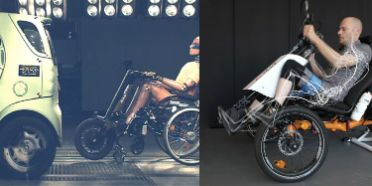- Research Project
Development of an electric drive for wheelchairs (GO-Quad)
The project aims to find a solution for the stability issues of wheelchairs with an electric drive.
Factsheet
- Lead school(s) School of Engineering and Computer Science
- Institute Institute for Energy and Mobility Research IEM
- Duration (planned) 01.01.2022 - 31.12.2023
- Project management Prof. Sebastian Tobler
- Head of project Prof. Sebastian Tobler
- Keywords Wheelchair , scooter, electric assist, innovation, disability
Background
The assemblies comprising of a wheelchair and an electric drive (in the form of a scooter) are vehicles which aim to enable people with reduced mobility to travel as much as possible. In this type of system, all of the drive force is applied on the scooter’s front wheel. As the centre of gravity of these vehicles tends to lie at the back, it is difficult to transfer the wheel’s drive force to the ground when going uphill. A further problem is that the brakes applied by hand at the front of the scooter only work on the front wheel. When going uphill, the loss of grip can cause falls and potentially dangerous sliding. In conclusion, a single front drive wheel presents major stability issues, making it too easy for the vehicle to topple over on bends. Direct impact to the head (without a helmet) after tipping over at 10km/h (without being able to use legs or the upper body to brace the impact) presents a high risk of serious injury.
Procedure
The SCI-Mobility lab has launched a project to redesign this system. The thinking behind this project is to focus on the issue of transmitting the drive force in an initial stage. A method had to be found to avoid losing grip and to ensure the electric drive can always transfer power to the wheels. Proposals to provide better scooter stability also had to be produced.
Solution
The solution proposed by the SCI-Mobility lab is to transfer the drive force to the rear axle of the wheelchair. A system with a drive shaft and a differential is installed on the chair. This approach means the centre of gravity is much better positioned in relation to the drive wheels. This prevents scenarios where the drive wheels are destabilised and slip instead of transmitting power. With regard to stability, the single front wheel of traditional systems is replaced by two wheels; thus improving the front track and therefore stability too. This step significantly reduces the risk of lateral tilting at low and medium speeds.


